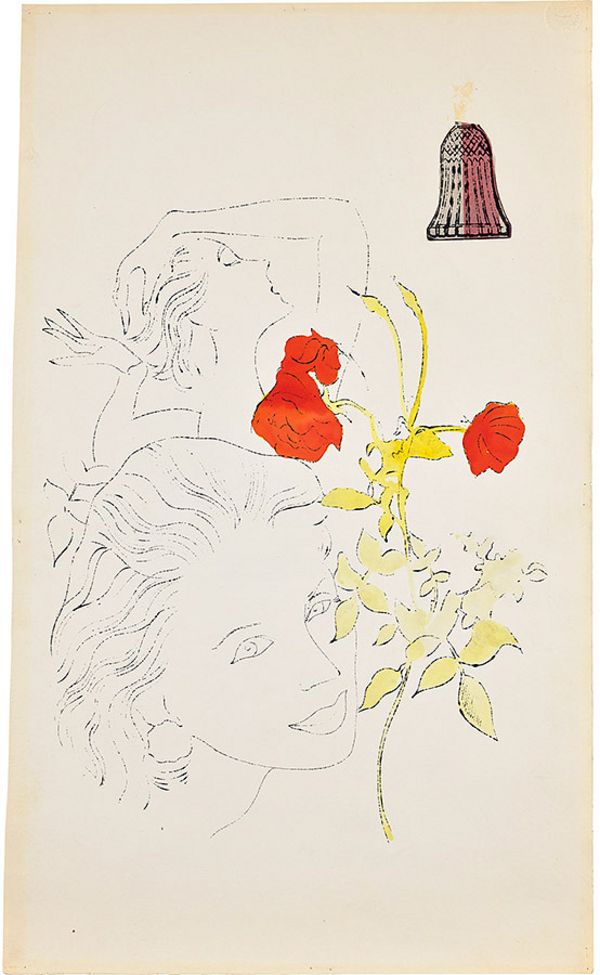Andy Warhol, Female Head with Partial Figure, c. 1957. Editions and Works on Paper. Click to view lot >
Warhol cognoscenti have come to appreciate his drawings of the 1950s as among the most prescient, intimate, and delightful in his oeuvre. Here, we explore nine of our favorites — among the 22 featured in our Editions and Works on Paper auction in New York on 15 February.
First, a Little Background...
Warhol in 1949 obtained his degree at Carnegie Tech (now Carnegie Mellon) in Pictorial Design. Coming to New York later that year to show around his portfolio, he was immediately snatched up by Alexey Brodovitch — the legendary art director of Harper’s Bazaar from 1934 to 1958 — illustrating the editorial feature “Success Is a Job in New York.”
In that triumph that launched his initial success as an illustrator, he staged a series of kitten heel pumps on the rungs of ladders as a stand-in for the City’s sophisticated young working women — that style of shoe then just coming into fashion as their office wear of choice. Due to a misprint in the illustration credit, the “a” at the end of Warhola — his proper name — was inadvertently dropped. Andy ran with it from that moment on.
Thus begins the gorgeous first chapter of Warhol’s career, which runs all the way to his breakthrough discovery of the silkscreen medium in 1962. Throughout the 1950s, he never stopped drawing. He became famous for his editorial illustrations in popular women’s magazines and retail collateral and ads for shoe and fashion accessories brands. He even developed promotional booklets of his own to share with clients. But he also drew for himself and for colleagues and friends. And he drew for art!
The boundary between commercial illustration and fine art in the early decades of the 20th century had been more porous than it was becoming in the Post-war years. Warhol developed his style in jumping agnostically from one arena to another, but his visibility as a commercial artist caused many to dismiss his oeuvre as unserious. All the while, he was aspiring to high art. His first solo in NY was at Gallery Hugo in 1952, entitled Fifteen Drawings Based on the Writings of Truman Capote. Then in 1956, he participated in Recent Drawings U.S.A., a large survey at MoMA.
What is clear about Andy Warhol from the first is his love of line and contour. Line art was commonly preferred in the sophisticated cosmopolitan illustrated magazines of that era, to be sure. It also came to the fore in the world of fine art in the works of Ben Shahn — who reigned as the pre-eminent master through the mid ‘50s. However, Shahn wielded his authoritative line with a heavy hand to render the gamut of the city’s real people. Warhol — who acknowledged him as a primary influence — updated his own line to a light-handed dance of wit and whimsy that brought fantasy and beauty into focus.
Now For the Drawings You've Been Waiting For...
In Female Head with Partial Figure (pictured above), one lovely woman gazes up adoringly at a single stem of three red roses in bloom that floats before her like a vision of romance. Her over-sized button earring with dangling drops is a chic, modestly promiscuous nod to Italian fashion, just then all the rage — at a time when few American women even had their ears pierced — owing to the influence of Fellini’s La Strada (1954) and The Nights of Cabiria (1957). Warhol was always au courant.
Rising up from behind her is a second beauty, every bit her twin in the glamourous style of 1957 — the coquettish soft bob, inspired by legendary stylist Alexandre de Paris and made famous by Liz Taylor and Marilyn Monroe — a high-maintenance, faux-natural confection of waves and curls meant to emphasize the eyes, which were heavily made-up in that era. But hers are closed in sensual and ecstatic abandon. One is left to imagine we are glimpsing into her heart — at the overturned bell-shaped bowl of the cut-crystal Pousse café cordial glass — a collaged element here that hovers in her line of sight — broken free of its stem — which mirrors the full-skirted silhouette of Dior’s New Look, a favorite of Princess Margaret and young women of style around the globe as a manifest rejection of the previous decade’s the wartime austerity.
It is a complex, multi-layered composition inviting a multiplicity of readings. We look down upon the first damsel and directly at the second. The straight underbelly of her forearm together with the lip of the glass comprise the horizon line. Venus sprung from the head of Persephone? The progression from courtship to marriage —as signified by the broken glass, a cornerstone of the traditional Jewish wedding ceremony? Warhol here engages us in a game of wit that is anything but literal.
Much of the drawing’s charm resides in the shimmering line quality, which is very typical of his signature blotted line work. His technique was to project and trace an image onto a nonabsorbent sheet. He could then multiple times hold tight to the contours with additional applications of ink that he would then blot onto additional sheets to explore a rich array of color variations. Though an effect of the blotting, he developed the technique in this period to maximize the ethereal character of his line.
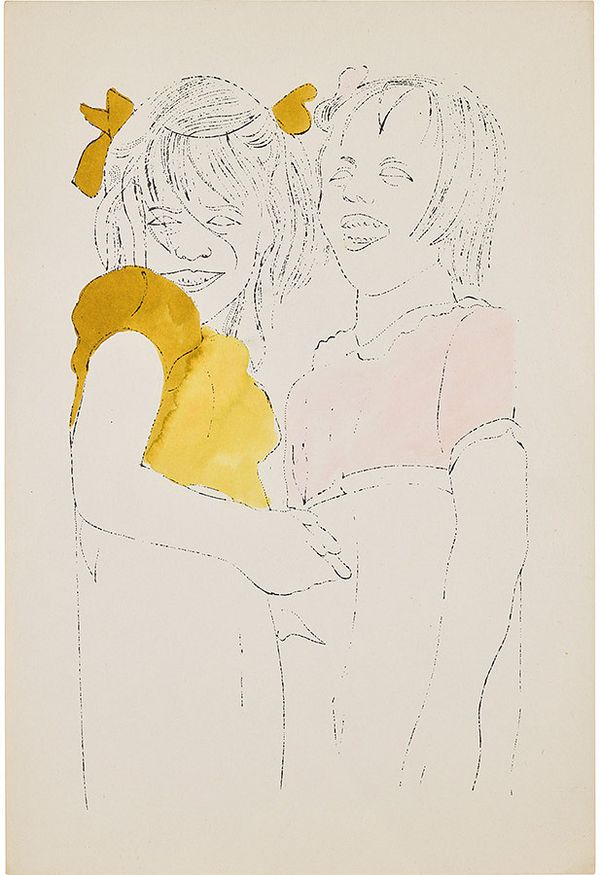
Andy Warhol, Two Girls Laughing, 1954. Editions and Works on Paper. Click to view lot >
Warhol’s lightness of touch flowers into a burst of unmitigated delight in his hand-colored litho Two Girls Laughing of 1954. It’s a candid moment of hand-holding tenderness, the pair possessing a natural charm, with a total lack of guile or artifice — presumably the envy of every Park Avenue cocktail party hostess. Cousins, best friends, sisters, perhaps even twins…? They are a winning combination, completely merged as one, together in the moment.
I love the giddy, open-mouthed surrender of the one. What makes the picture for me, though, is that darling gesture of mild shyness of the other, as she lifts her short puff sleeve to hide her big beaming smile. Warhol renders it so perfectly with that swelling puddle of gold paint, it’s as though he’s in on it — as one who knows the feeling well. That for me raises this image to the level of an icon.
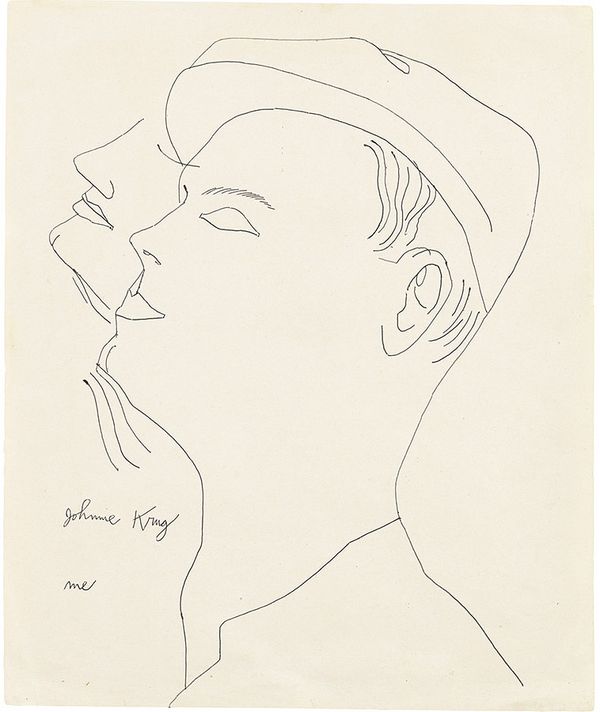
Andy Warhol, Johnnie Krug and Me, c. 1955. Editions and Works on Paper. Click to view lot >
In 1951, a colleague introduced Warhol to fashion photographer Otto Fenn. The two quickly became friends and Andy was a regular visitor to his photo studio on 58th Street, where men often gathered to dress in drag and perform in Fenn’s all-male theatrical adaptations of popular films such as, in 1952, George Cukor’s romance Camille (starring Great Garbo).
In addition to posing for Fenn, Warhol allegedly collaborated on a number of Fenn’s sets and made work based on their productions. And any number of Warhol’s drawings of the 1950s were based on Fenn’s images, including this one, Johnnie Krug and Me from 1956.
Krug was to be Fenn’s lifetime partner. That was the year they met. In 1964, the couple moved to Long Island to open the Sag Harbor Antiques Shop, a beloved institution they operated there for decades.
In his definitive biography of Warhol, Blake Gopnik references the original photo, describing Warhol’s nose in it as having been “surgically” doctored to achieve that “ski-jump” contour — similar to Warhol’s famous vanity alteration in Passport Photograph with Altered Nose of that same year.

Andy Warhol, A Profile of a Young Man Looking Up, c. 1955. Editions and Works on Paper. Click to view lot >
One wants to imagine Warhol’s dreamy Young Man, 1955 as a specific someone. With his small pointy nose and upturned quiff hairstyle so typical of that era — he most resembles Johnny Carson, circa 1955. It’s more likely an idealized imaginary self-portrait.
In The Philosophy of Andy Warhol, he writes, “When I did my self-portrait, I left all the pimples out because you always should. Pimples are a temporary condition and they don't have anything to do with what you really look like. Always omit the blemishes – they're not part of the good picture you want.”
In this drawing, he leaves out the ear as well — as he was sometimes wont to do — imparting to the head a dreamlike volumetric buoyancy. It’s the profile that interests him.
A facial silhouette is a reductive capture of one’s features. The popular genre of silhouette portraits directly traced from a shadow that took off in the 18th century interestingly parallels both Warhol’s commercial technique and his fascination with contour and proportion as evidenced by his perfect renderings of shoes. One’s profile is like the signature of one’s personality.
Small, cute noses were 'in' back in 1955. The list of Hollywood stars who had a little work done is long and not so secret anymore. It includes Liz Taylor, Marilyn Monroe, and Carmen Miranda and men, as well, like Burt Lancaster and Dean Martin. Rhinoplasty soared in popularity among all who could afford it. Warhol commenced on a nose job illustration that ran in The National Enquirer in 1961, and quickly commenced on his Before and After series of 1962 to make the point. The diminutive noses then in fashion were “American” noses. He never liked with his nose. But this nose on this drawing takes the cake. It is just too perfect to be real.

Andy Warhol, Costumed Figure, c. 1955. Editions and Works on Paper. Click to view lot >
Warhol’s Costumed Figure, c. 1955 depicts a prosperously bellied French gentleman, playing at the game of diabolo. This circus and parlor amusement had arrived in Europe in the last decade of the 18th century as a variant of the traditional Chinese yoyo (and a cousin of the modern Duncan Yo-Yo) and was, by 1810, all the rage.
Conspicuously absent here is the diabolo itself, which was meant to ride back and forth on the string between the two poles and be flung acrobatically into the air and caught again — for hours of endless entertainment.
The diabolo itself was composed of two cups glued together at the base, closely resembling resemble an hourglass. Also notably missing is the cunning of this man’s physique — which in no way matches the hour-glass silhouette his clothes were designed for.
Men’s bodies in the Romantic Era and the fashions that clothed them aspired to svelte Byronic proportions. Tailcoats, waistcoats, and pants were all worn tight and tapered to emphasize the graceful arabesque of an heroic young figure. In this era, fashion plates from Paris circulated quickly to elite subscribers round the world.
Well-subscribed engravings of Caricatures Parisienne soon followed, with satirists having a field day with portly chaps looking ridiculous in the latest cuts. A recurrent theme was “Le Gout de Jour (The Taste of the Day)” — which often fixated on the fleeting fashions of the Napoleonic gentry and such idle amusements as seesawing, badminton, and diabolo. Although Warhol’s source material for his drawing remains unlocated, it is also captioned "Le Gout de Jour" and it so parallels others in the collection of The Carnavalet-History of Paris Museum, circa 1830 that it likely belongs to that series.
Make no mistake. The fellow he depicts is a fashion victim and dimwit. His bowtie lavallière is silly. He’s removed his tailcoat for action, but he sets his feet far apart as though he has difficulty managing to even balance himself. The wad of cash in his pants pocket is ripe for the picking. His sticks resemble conducting batons, which typically signify control and mastery, but clearly he has none. And his string is quite limp. This is Warhol at his most droll.
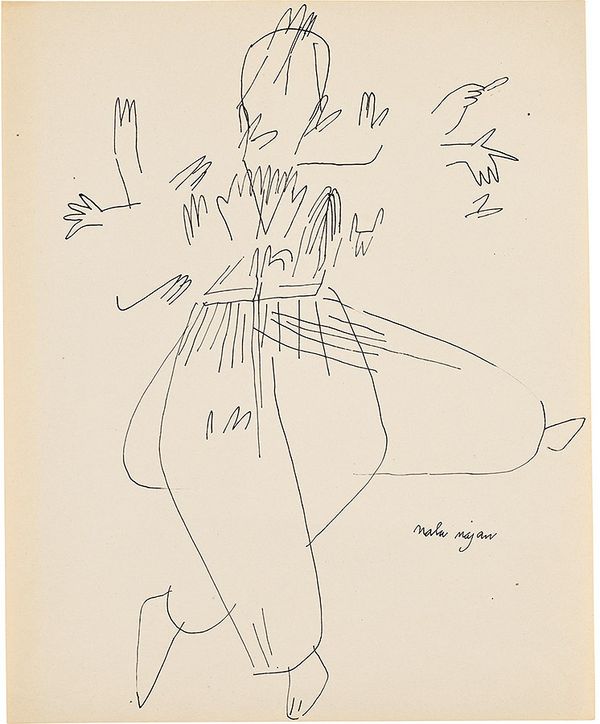
Andy Warhol, Nala Najan, c. 1952. Editions and Works on Paper. Click to view lot >
Nala Najan was the first and foremost American champion and master of classical Indian dance, particularly the Bharatanatyam, the most ancient of the classical Indian dance forms — with deep roots in Hinduism going back to the 2nd century. Many ancient Shiva sculptures in Hindu temples are based on Bharatanatyam dance poses, often featuring the god with six or more arms.
Warhol’s drawn portrait captures the intense animation of Najan’s hypnotic moves in the comic book vernacular of the motion blur, while simultaneously alluding to the dance’s inherent connection to Shiva’s explosive destruction of the world at the end of each cosmic cycle in preparation for its rebirth in a new age to come — an intriguing Cold War reference to the atom bomb.
The strikingly handsome dancer was born Roberto Rivero in Pennsylvania in 1932 to a Spanish mother and Russian father and took on the more exotic sobriquet after extensive study with his guru in India in the late 1940s — now legendary — at a time when classical forms were undergoing a renaissance there after the collapse of British rule. In 1950s New York he was a phenomenon. He debuted with Gina Blau at the Kauffman Auditorium in 1954 and the following year at the Henry Street Playhouse and a host of other venues, winning both critical acclaim and a devoted following. But limited engagements resulted in Najan’s turning to the national university circuit, where he awakened the academic world to Indian dance but his reputation as a dancer fizzled. Impediments to further success are said to have been little serious interest in third-world cultural traditions, which seemed like exotic novelties at the time, and even less in solo male dance acts — which makes the androgyny evident in Warhol’s portrait all the more wonderful.
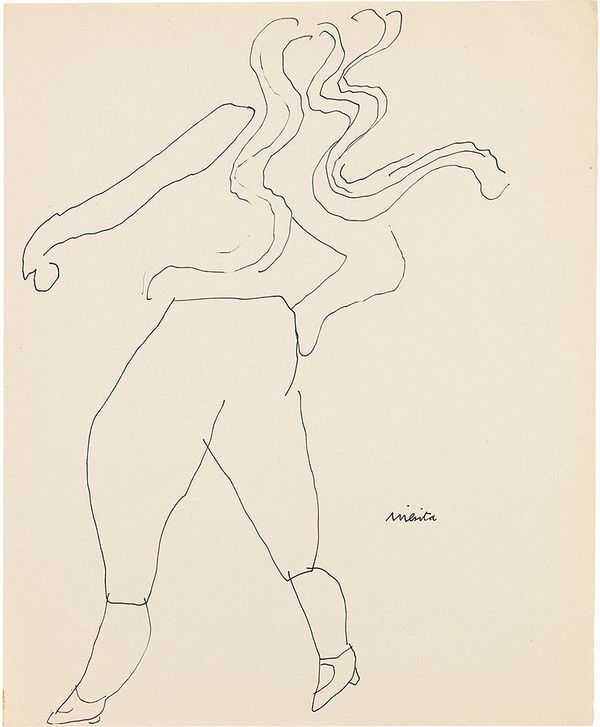
Andy Warhol, Meista, c. 1952. Editions and Works on Paper. Click to view lot >
In retrospect, Warhol’s Meista of 1952 feels so incredibly prescient. The figure’s tight capris pants and wildly swirling hair bring to mind the shockingly overt sexuality of Brigitte Bardot’s legendary 1956 blockbuster performance in And God Created Woman. The Art Nouveau lines even anticipate popular fashion illustration styles nearly two decades hence, in the 1970s — not to mention the dancer’s hip-swiveling moves.
The only obvious tell about the period is the dancer’s Mary Jane ankle-strap kitten heel pumps. Warhol always nails the shoes. These are the ones that a chic young woman of that era would have danced in — either out on the town or in the studio.
The 1950s were the golden age of the Broadway musical. Even the bulk of the contemporary repertory hails from this era. Everyone was dancing. But it was usually big band swing or later bop — still relatively stiff by today’s standards. Even the radical young Beat women of 1952 dancing to the rhythm of bongos didn’t get that loose — nor wear their hair so long and free.
It wasn’t just the famous celebrity scene as Studio 54. Warhol loved dance throughout his life. At Carnegie Tech in the late 1940s, he was an active member of the Modern Dance Club (although it is said that others in the group encouraged him to draw them rather than participate in performances). He famously long idolized Martha Graham. Then, in 1951, he took on Dance Magazine as among his first illustration clients, going on to do two covers for them in 1957. Some of his early films at the factory featured dance artists Kenneth King and Lucinda Childs. He later even collaborated with his friend Merce Cunningham, contributing his helium-filled Silver Clouds to Rainforest, 1968.
Warhol was also a devotee of the experimental and avant-garde Judson Dance Theater (1962–64) — where Post-Modern dance was born — especially when it came to ballet-trained Freddy Herko — among the most beautiful men on the scene in the 1960s — and one of Andy’s first Superstars.
1946 to 1957 is known as the Late Modern Dance period. Martha Graham’s influence could still be felt in the work of influential choreographers reinventing dance at the time, like José Limón, Merce Cunningham, Anna Sokolow, and Anna Halprin.
The person in Warhol’s drawing is unidentified. He doesn’t name her. Doesn’t even show her face. Maybe it doesn’t matter…? Just an iconic dancer. But it’s hard to imagine she’s just any old girl. My money’s on legendary Village Voice dance critic and feminist siren Jill Johnston (1929–2010). In 1952, she was just coming off her second year at the American Dance Festival at Connecticut College — the “Black Mountain for dance” in that generation — and returned to New York as a student of José Limón. The age is about right. She wore her hair long. She’d been Freddy Herko’s dance partner at Judson. She resurfaces in Warhol’s oeuvre in his 1964 film Jill Johnston Dancing at the Factory. Circumstantial evidence, perhaps — but it’s got to be her!

Andy Warhol, Four in One, 1955. Editions and Works on Paper. Click to view lot >
Animals loved people in the 1950s. And people loved animals — especially our domesticated and anthropomorphized pals who lived in the world of popular entertainment: Ronald Reagan costarred with a chimp in Bedtime for Bonzo (1951). Wilbur the pig was introduced to the world in Charlotte’s Web, E. B. White’s long-celebrated children’s classic of 1952. George Orwell’s Animal Farm came to the big screen as an animated feature in 1954, bringing Napoleon the pig and a host of barnyard animals to life in brilliant color. Lassie hit the airwaves in 1954. And Linda the Llama out about in the City hit the pages of Life magazine in the mid ‘50s.
Nor were the rarified echelons of elite New York immune to the charm.
In Warhol’s drawing Four in One of 1955, the artist presents uniquely Warholian, curlicued renditions of a ram, a camel, and an alpaca llama — four friendly barnyard beasts — facing off against a wee, roly-poly little lamb. It calls to mind a nursery rhyme, but none can be found that easily fits.
In style, it closely resembles a suite of drawings entitled The Wonderful World of Fleming-Joffe, which he did later in 1960 for the haut New York leather accessories retailer, to be presented in their promotional booklet with an animal character representing each of their luxury product lines — such as a snake for snakeskin.
The material substrate on which it’s drawn suggests that Warhol undertook it as the master drawing for a subsequent series of blotted line drawings — perhaps as a prelude to the above project — although it’s not clear he ever did any from it.
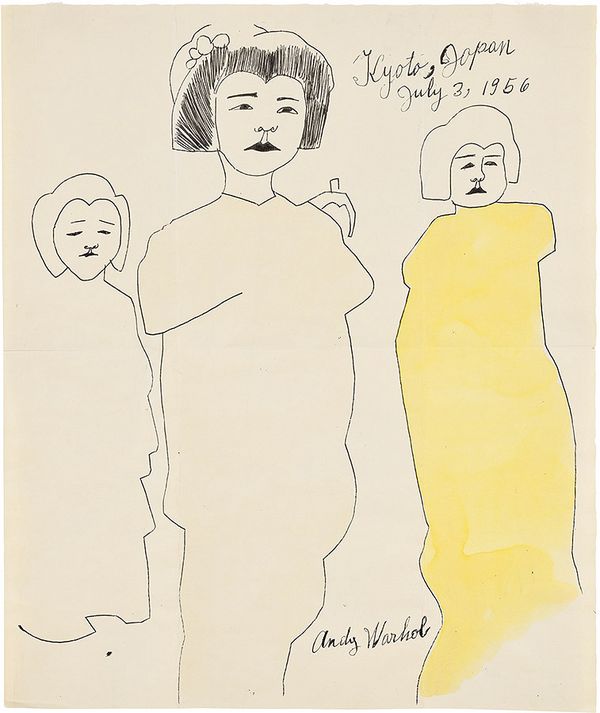
Andy Warhol, Kyoto, 1956. Editions and Works on Paper. Click to view lot >
As a reward for seven years of success as commercial artist, in 1956, Warhol made a two-month trip round the world with boyfriend Charles Lisanby — first stop Kyoto, Japan, where he stayed for two weeks.
The city — having been spared from both conventional bombing and nukes during the war — retained much of its historical charm and was widely promoted in the U.S. as the nation’s ancient cultural capital, the home of geishas and pagodas. This propaganda, aimed to distract from the modern realities of Japan, sparked a craze for traditional Japanese culture. Notes Meghan Warner Mettler in her book How to Reach Japan by Subway: “Americans came to view Japan as a nation that was sophisticated and beautiful yet locked harmlessly in a timeless 'Oriental' past. What ultimately led many Americans to embrace Japanese culture was a desire to appear affluent and properly 'tasteful' in the status-conscious suburbs of the 1950s.”
The three female figures in Warhol’s drawing Kyoto, 1956 wear kimonos — or yukatas, which are the simpler, lightweight cotton or linen version for summer. Their faces are painted in traditional geisha oshiroi style, with a base of white and stylized lips and eyes that are intended to hide their true emotions. Their precise age is difficult to gauge but they look young. Their ensemble arrangement in Warhol’s drawing appears formal and staged. That they are presenting themselves in a public dance performance seems likely.
Americans first became acquainted with the geisha concept through Puccini’s opera Madame Butterfly before the First World War. An Italian musical film version was released with English subtitles for U.S. distribution in April of 1956 and may well have influenced Andy's decision to go.
The world-famous geishas of Kyoto perform at small private gatherings in the teahouses of the geisha districts. They were always highly respected and accomplished masters of the performing arts and conversation, whose role evolved in the Edo period (1603 – 1867) to entertain and engage wealthy men with their grace, beauty, and dignity. Intensive training in traditional dance and music began for a geisha at the age of seven or eight. Geisha means ‘artist.’ In Kyoto, they prefer the term geiko, which means 'arts child.' It is a rare treat for visitors from overseas to get to see them.
This was his first trip abroad — an epic adventure — taking him as far from Pittsburgh as possible, which was always his highest aspiration. He went to experience first-hand the rich fullness of Japanese culture, its dance and cuisine in particular, which was a luxury few at the time could afford.
On this sojourn, due to the language barrier, he slips into the role of active observer more than ever. Notably, he begins his life-long fascination with the civility of Japanese omakase cuisine. The literal translation is “I'll leave it up to you,” which is what one says to a master sushi chef (from 任せる, makaseru, 'to entrust'). Warhol was always a people watcher. In that context, omakase makes all the sense in the world. He doesn't need to know. He is simply fascinated.
by Don Carroll
Auction /
15 February
432 Park Ave, New York, NY, United States, 10022 (map)
Viewing /
6 – 15 February
Monday – Saturday 10am – 6pm
Sunday 12pm – 6pm
Recommended Reading
The Delightful, The Surreptitious, The Unexpected: Stories about five editions that are anything but ordinary >
What Soulages Sounds Like: The art of Pierre Soulages meets the music of Gérard Grisey >
